The 6,387 drawings of collection
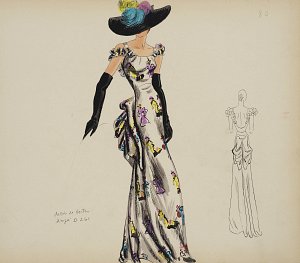
Elsa Schiaparelli, Collection drawing, Summer 1939
Drawing. Musée des Arts décoratifs
© Les Arts Décoratifs
The donation made by Elsa Schiaparelli
to the UFAC in 1973 included 6,387
collection sketches dated from 1933
to 1953 and compiled in 55 bound and
loose-leaf albums. These unsigned
drawings were made in graphite, coloured
pencil, ink, felt-tipped pen, watercolour
or gouache on drawing paper. Following
the presentation of a collection in the
salons of the maison de couture, artists,
employed by the Maison Schiaparelli,
would rapidly and carefully reproduce the
silhouette of a model wearing the design.
[…] Unlike drawings signed by illustrators
in fashion magazines, these drawings
were never intended to be published.
Along with the programme that indicated
the theme and trends of the collection
and was distributed to those invited
to see the collection, the drawings were
intended as tools to convey technical
information and promote the collection
to clients unable to see the collection
in person, allowing them to place orders
from a distance. […]
The collection drawings constitute a living
memory of the numerous pieces created
by Schiaparelli over twenty years and four
annual collections: Spring, Summer, Fall
and Winter. They show the rich variations
in a collection and the ever-active
power of seduction of Elsa Schiaparelli’s
creations.
Costume Jewellery
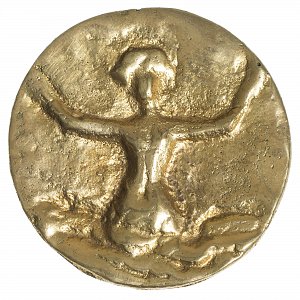
Alberto Giacometti, Button 1937
Golden bronze. Musée des Arts décoratifs
© Les Arts Décoratifs
The Schiaparelli silhouette was composed
of clothing, accessories – hat and
gloves – and jewellery, made by master
jewellers, that lent a harmonious and
ornamental touch to the ensemble. Called
“paruriers,” these makers of costume
jewellery worked in the background and
never signed their contributions. The
theme of each collection was transmitted
to the artisans, who then proposed
jewellery in the same spirit. Schiaparelli
surrounded herself with people who
had strong personalities, capable
of understanding her fantastical vision
and also surprise her. Jean Schlumberger
interpreted with elegance the Surrealist
spirit of the couturière. The jewels
of artists Alberto Giacometti and Meret
Oppenheim were equally surprising. In her
memoirs, Schiaparelli spoke glowingly
about other collaborators: faithful Jean
Clément “a genius at what he did,” Elsa
Triolet, the wife of poet Louis Aragon, who
created necklaces in the form of aspirin
tablets, and silversmith François Hugo, the
great-nephew of Victor Hugo, who made
buttons for the designer.
Jean Cocteau, A Poetic Line
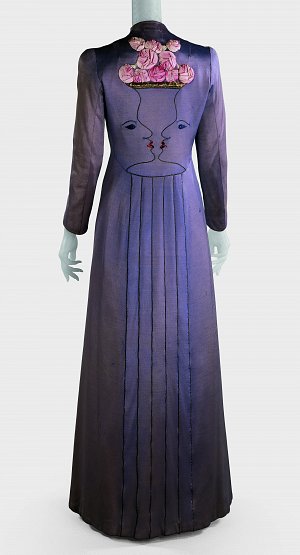
Elsa Schiaparelli, Evening Coat, Fall 1937
Rayon knit, Silk embroidery and flowers by Lesage
© Philadelphia Museum of Art
As proof of their friendship, poet Jean
Cocteau offered two drawings to Elsa
Schiaparelli, whom he considered
to be “the most eccentric of designers.”
The couturière transferred the drawings
to an evening coat and a suit jacket in the
Fall 1937 collection. The continuous line
of the drawing embroidered onto the back
of the coat gave the illusion of a double
image: that of two faces in profile looking
at each other, and that of a vase sitting on
a fluted column, crowned by a bouquet
of roses. The collaboration, which exalted
poetic imagination, was also evident
on the evening jacket in the form of a line
that traced the contours of a feminine face
with long golden hair embroidered down
the sleeve. The name Jean punctuated
with a star was Cocteau’s monogram.
In her memoirs, Schiaparelli calls his film
Blood of a Poet (1930) Surrealist, though
he always refused the label. According
to the artist, he was attempting to imitate
a waking dream, which allows one, like
magic, to pass through to the other side
of the mirror.
The Butterfly and its Metamorphosis
Elsa Schiaparelli chose a theme for each
of her collections. For Summer 1937
it was the butterfly. According to the
presentation in the show’s programme, the
collection’s summer prints were intended
to evoke a dance in which singing birds,
buzzing bees and joyful butterflies all
united in harmony. For the designer,
as for the Surrealists, the butterfly was
a source of marvel and aesthetic emotion.
Because they are born from an egg,
transformed into caterpillars and then ugly
chrysalids, butterflies were considered to
be a symbol of the fragility of beauty and
the brevity of life. The beautiful insect,
with its fluid movements and velvety
wings, always flying just out of grasp, was
compared, like a fairy tale, to women and
their inconstant hearts. The butterfly is
at the origin of Apuleius’ 2nd Century story
of the beautiful Psyche (a Greek word
that means both soul and moth) who falls
under the spell of a monstrous god.
Meret Oppenheim, Surrealist Artist
Swiss – German by birth, artist Meret
Oppenheim arrived in Paris in 1932 where
she became close to André Breton,
head of the Surrealist movement, and
photographer Man Ray. In the spring
of 1936, she sold Elsa Schiaparelli
a design for a piece of jewellery:
a brass bracelet covered in animal fur
that Schiaparelli included in her Winter
1936 – 37 collection. Meret wore the
bracelet at the Café de Flore in the
company of Pablo Picasso and Dora
Maar, who admired it. Over the course
of their conversation, a project was born
to cover every object on the table in fur.
Their tea having gone cold, they ordered
a “bit more fur” from the waiter! Invited
by Breton the following May to participate
in an exhibition of Surrealist objects at
the Galerie Charles Ratton, Oppenheim
presented Le Déjeuner en fourrure
(Lunch in Fur): a teacup, saucer, and
spoon, covered in fur. This surrealist
set of objects was bought by Alfred H.
Barr for the collections of the Museum
of Modern Art in New York.
Leonor Fini, The Triumphant Femininity
of Shocking Perfume
Born in Buenos Aires of Italian origin
(from Trieste), Leonor Fini arrived
in Paris in 1931. Presented to Christian
Dior by Max Jacob, she showed her
paintings in the Galerie Bonjean directed
by Dior. Schiaparelli discovered her
fantastical creative universe peopled with
mythological feminine figures. In 1936 she
painted the portrait of Gogo Schiaparelli,
Elsa’s daughter. At the couturière’s
request, Fini designed the Shocking
perfume bottle.
Place Vendôme

François Kollar, Madame Schiaparelli, 1938
Photograph
© RMN – Gestion droit d’auteur François Kollar, Charenton-le- Pont, Médiathèque du patrimoine et de la photographie © Ministère de la Culture - Médiathèque du patrimoine et de la photographie, Dist. RMN-Grand Palais / François Kollar
By the mid-1930s, Elsa Schiaparelli
had come to the forefront as a premier
couturière. In 1933, she opened
a boutique in London and in January 1935
she moved out of her shop at 4, Rue
de la Paix, which had become too small.
She chose to open her new Paris shop
in a mansion at 21, Place Vendôme, whose
façade dated from the 17th Century. […]
On the ground floor of the building, was
the Boutique Schiap which sold, “prêt-àporter:”
evening sweaters, skirts, blouses
and accessories. She called on Jean-
Michel Frank for the interior design of the
three principal salons de couture whose
Louis XV woodwork was painted white.
For Frank, elegance meant eliminating
things to attain simplicity. He worked
with Alberto Giacometti to design the
rare decorative elements, like the plaster
columns topped with shells that housed
lighting. Dramatically draped curtains
lent a theatrical touch to presentations
of the collections by models in the
streamlined, monochrome rooms.
Light played a fundamental role in shaping
the space and contributed to creating
a surreal and strange atmosphere, in the
manner of a Dalí landscape. The central
presence of the Vendôme column is felt
in a collage given by Marcel Vertès
to Schiaparelli in 1953, the year before
the company closed. A veritable resumé
of the designer’s most emblematic
pieces, the work, by the artist
of Hungarian origin, was a vibrant homage
to Schiaparelli’s inventions.
The Perfume Cage
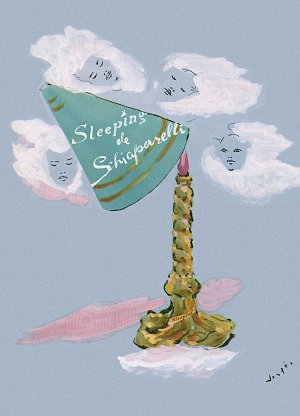
Marcel Vertès, Advertisement for the Schiaparelli perfume Sleeping, 1945
© Archives Schiaparelli
In February 1934, Elsa Schiaparelli,
superstitious, launched three perfumes:
Soucis, Salut and Schiap, all three
of which began with the letter ‘S’.
The trapezoidal bottle for Salut and its
cork box were designed by Jean-Michel
Frank. In June of 1935, on the ground
floor of the maison de couture, a perfume
cage imagined by Frank was installed.
Its structure, in golden bamboo and
black metal, allowed for a spectacular
presentation of perfume and cosmetics.
The Boutique Schiap raised the curiosity
of tourists to meet the wooden couple
holding court: Pascal “the permanently
Greek beauty” and his faithful Pascaline.
In April 1935, the perfume Shocking, with
its bottle designed by artist Leonor Fini,
became the successful signature of the
house. In January 1947, the Parfums
Schiaparelli group moved to a modern
laboratory in Bois-Colombes where the
perfume Le Roy Soleil, with its Baccarat
crystal bottle designed by surrealist
artist Dalí, was produced in a very
limited edition.
The Commedia dell’Arte
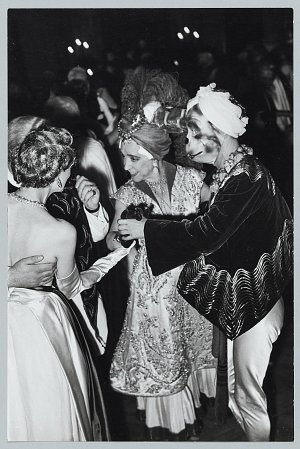
Nepo Arik, Elsa Schiaparelli dansing with a man wearing a Schiaparelli jacket at a Fath Ball at Corbeille, 1952
© Elsa Schiaparelli SAS © Droits réservés, Paris, Palais Galliera - Musée de la mode © Paris Musées, Palais Galliera, Dist. RMNGrand Palais / image ville de Paris
The theme of Commedia dell’Arte
defined the Spring 1939 collection. This
form of comic theatre originated in the
popular Italian culture of the 16th Century.
The plays were performed by masked
characters, identifiable by their familiar
costumes, speaking improvised dialogues
that made the public laugh and react
out loud. Arlequin’s costume, a diamond
mosaic, was reinterpreted with elegance
by Schiaparelli in a series of evening
coats. A great lover of the sumptuous
masked balls and costume parties
organized by her clients, Schiaparelli
developed in this collection her taste
for amusing disguises. Her theatrical
references were shared by painter André
Derain who painted Arlequin and Pierrot
with great melancholy. The title of the
collection, likely intended to be ironic,
echoed the worrisome comedy being
played out on Europe’s stage that year
following the Munich accords that had
been signed in September 1938.
The Signs of the Zodiac
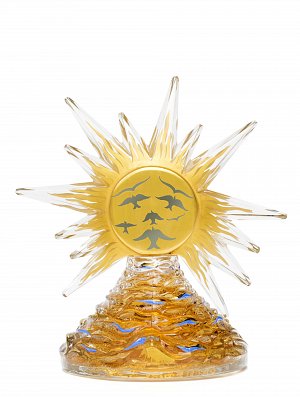
Salvador Dalí and Baccarat, Perfume Bottle Le Roy Soleil, 1946
Crystal
© Archives Schiaparelli
Observing Elsa Schiaparelli’s face, her
astronomer uncle Giovanni Schiaparelli
compared the beauty spots on her left
cheek to the seven stars in the Big Dipper
constellation. She made it her personal
trademark and often decorated her
creations with it, along with other celestial
motifs. The Winter 1938 – 39 collection
shone with signs of the Zodiac, planets
and constellations. The theme was fleshed
out with references to the reigns of Louis
XIV and Louis XV, the château, and
gardens of Versailles where, harmonious
connections between the seasons and
the planets were represented throughout
the interior and exterior design. A cape
was embroidered with Phoebus,
a reference to the Sun King, while the
Manufacture de Sèvres, created by Louis
the 15th, inspired the decoration of a coat.
A jacket covered in fragments of mirrors
in baroque-style golden frames, was
perhaps inspired by the doors in the
Versailles Salons of War and of Peace.
Circus

Elsa Schiaparelli, Boléro Cirque, Été 1938
Broderie de ganse
de soie sur crêpe de soie,
broderie de fils de soie,
lacets, cabochons, perles
et miroirs par Lesage.
Musée des Arts décoratifs
© Les Arts Décoratifs / Christophe Dellière
The Summer 1938 collection was built
around a circus theme. Its presentation,
the 4th of February 1938 in the private
salons at Place Vendôme, took the form
of a burlesque show that enchanted
those present. Elsa Schiaparelli wrote
in her memoirs that it was the most
“tumultuous, most audacious, collection”
where clowns were let loose in a crazy
dance. Elephants, trapeze artists and
horses decorated the bolero evening
jackets. Composed of 132 pieces, the
inventive and joyous collection combined
references to the circus with the Surrealist
movement. And indeed, the collection’s
show coincided with the International
Surrealism Exhibition, organized in Paris
by André Breton and Paul Eluard, in which
artists Marcel Duchamp, Man Ray, Pierre
Roy and Salvador Dalí, among others,
participated. The human-skeleton circus
number was at the outset a bony skeleton
embroidered on an evening gown, inspired
by a Dalí drawing.
The art of Embroidery
In 1934, Elsa Schiaparelli asked Albert
Lesage, head of an embroidery studio,
to work on several embroidered belts.
The collaboration went well and from
1936 on she turned to him to add handembroidered
decoration to her creations,
illustrating the themes of her collections.
Highly regarded for his creative talent and
his savoir-faire, Albert Lesage’s embroidery
was faithful to Schiaparelli’s inventiveness
and her fine sense of humour. It was
a stimulating exchange: an embroidery
sample could end up influencing the
design of a dress. For a collaboration with
Cocteau in 1937, Lesage embroidered
the poet’s drawings, in particular that
of a magnificent woman with golden
hair, on a linen jacket. The Lesage
studio also fabricated the little bouquets
of flowers that decorate the Shocking
perfume bottle. In 1949, François Lesage
succeeded his father and pursued the
studio’s collaboration with Schiaparelli
until 1954.
-

Elsa Schiaparelli, Bolero Circus, Summer 1938
Silk embroidery, laces,
tiles, pearls and mirrors by Lesage. Musée des Arts décoratifs
© Valérie Belin
-

Daniel Roseberry, Look 10, Spring-Summer 2022
Photograph
© Maison Schiaparelli